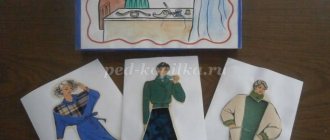Didactic games “Professions” in the preparatory group
Older preschoolers are preparing for school, so games are important for them to develop speech and improve their skills in correctly forming sentences.
Divide the word
The presenter names a profession formed from two words. Children try to break it into pieces to find out the meaning. For example, “chimney sweep - pipes and clean”, “fisherman - fish and catch.”
Choose a word for your profession
The player’s task is to choose a suitable epithet for the profession. For example, “the teacher is kind,” “the ballerina is slender,” “the nurse is caring.”
Continue the sentence
The teacher begins a sentence concerning the professional responsibilities of various workers, and the students complete it by listing the objects of action. Eg:
- the gardener waters... the lawn, flower bed, bushes, trees, beds;
- the cook cuts with a knife... meat, vegetables, fish, fruits, bread;
- the driver carries passengers by... taxi, bus, tram, trolleybus.
Didactic games “Professions” in the younger group
Preschoolers of the younger group learn through games how important all professions are and what different workers do.
Salon
Pupils do the dolls' hairstyles and take care of their hair using various devices and products. The teacher observes the work of the pupils, coordinates them, and suggests rules for caring for their appearance. It is important to draw children’s attention to how ugly dolls look while they are unkempt and unkempt, which means that the profession of a hairdresser is necessary. You should also tell children about the tools used in the hairdressing salon and their purpose.
Guess the profession based on the subject
The teacher pulls an item out of the bag, and the children say who might need it. For example, a cook needs a ladle, a nurse needs a bandage, a painter needs a brush, and a hair dryer needs a hair dryer.
Guess who am I?
Children stand in a circle. Each player, in turn, goes to the center and begins to depict a certain action, without saying a word, using only facial expressions, body movements, and inarticulate sounds. The rest must guess who the comrade is portraying. For example, a child makes twisting movements with his hands, imitating a steering wheel, and says “w-w-w.” This is the driver.
Correct mistakes
The presenter names paired phrases, and the children say what the mistake is and how to say it correctly:
- the teacher mows the lawn and the gardener writes on the blackboard;
- a barber puts out a fire, and a fireman does a haircut;
- a musician paints the walls and a painter plays the piano;
- the nurse prepares a pie, and the cook gives an injection to the patient;
- the builder offers books to readers, and the librarian builds brick walls.
Didactic games “Professions” in the middle group
The task of a teacher in the middle group is to expand and consolidate students’ knowledge about different professions, develop their thinking ability, concentration, ability to navigate, and give clear and competent answers.
What to whom?
To get acquainted with professions, the presenter names the worker, and the children must list the tools, devices and materials that he uses:
- doctor - syringe, stethoscope, medical gown, rubber gloves, bandage, medical card;
- builder - drill, hammer, bricks, boards, helmet, concrete, nails, saw;
- teacher - pointer, class magazine, textbooks, wall maps, blackboard;
- artist - paints, brushes, canvas, palette, easel, paper, pencils;
- cook - dishes, oven, blender, cap, apron, food, recipe book;
- hairdresser - hair dryer, combs, scissors, curling iron, hair dyes, hairpins, mirror;
- gardener - rake, gloves, shovel, seedlings, lawn mower, pruning shears, watering can;
- seamstress - sewing machine, iron, ironing board, scissors, fabric, needles, threads.
This is true?
For the game you need to prepare pictures depicting people of different professions in appropriate attire. Each player receives two cards: red – the answer is “no”, green – “yes”.
The presenter shows the children a picture and says who the person drawn works for. Players must understand whether what is said is true and raise the appropriate card. For example, the presenter, showing a picture of a fireman, says: “This is a teacher.” Children hold up a red card.
Work clothes
To play, you need to cut out paper images of a girl and a guy, as well as different work clothes.
The teacher says that the paper characters are going to go to work, but they need help choosing the right suit. The game can be built in different ways. The teacher names a profession, and the children choose the correct one from a heap of paper clothes. Or the teacher chooses the costume himself, and the players name the character’s place of work. When the children have sorted out their work wardrobe, the teacher asks them to close their eyes to consolidate the acquired knowledge, and he himself rearranges the clothes and asks them to find the mistake.
Work transport
To play, you need to arrange chairs and attach to each chair an image of a specific car: ambulance, fire, police, bus, plane, train and others. And cut out “steering wheels” from cardboard with professions written on them.
The presenter gives each player a steering wheel and names their profession. The player must find his “car”, sit on a chair, steer, “going to work”. The game is repeated, the presenter changes the players' steering wheels.
For a cook or a doctor?
This didactic game “Professions” for kindergarten systematizes ideas about the work responsibilities and professional characteristics of a cook and a doctor.
Two children are playing: one is a cook, the other is a doctor. The presenter pulls items out of the bag and asks which worker needs them. For example, a doctor needs a syringe, a cook needs a spoon. Children should not just answer, but explain why the employee needs this item.
Didactic games “Professions” in the senior group
Preschoolers in the older group should already know a wide range of professions, as well as have an idea of the professional responsibilities of different workers and the tools they use.
List professions starting with the selected letter
The teacher places cards with letters face down on the table. Children take turns coming to the table, taking a card, calling professions that begin with the chosen letter:
- A – actor, agronomist, astrologer, administrator, aviator, lawyer, architect, obstetrician;
- B – accountant, bookseller, bartender, banker, accordion player, librarian, ballerina, boxer;
- B – doctor, makeup artist, driver, diver, teacher, veterinarian;
- G – geologist, governess, loader, make-up artist;
- D – janitor, conductor, designer, nutritionist, truck driver, milkmaid, dispatcher, director;
- F – livestock breeder, journalist, jockey;
- Z – sound engineer, zoologist, manager;
- I – inspector, engineer, inventor, art critic, illustrator, historian;
- K - astronaut, clown, captain, combine operator, composer, cashier, fireman, blacksmith;
- L – laboratory assistant, pilot, lumberjack, speech therapist;
- M – driver, fashion model, painter, nurse, meteorologist, mechanic, installer, musician;
- N – nanny, notary, oil worker;
- O – ophthalmologist, waiter, operator, landscaper, security guard;
- P – shepherd, cook, pediatrician, writer, hairdresser, pianist, carpenter, postman, salesman;
- R – director, radio operator, fisherman, reporter;
- S – secretary, plumber, gardener, violinist, mechanic, sculptor, dentist;
- T – tractor driver, turner, chimney sweep, trainer;
- U – cleaner, teacher, scientist;
- F – photographer, florist, pharmacist, farmer, philosopher, football player;
- X – surgeon, artist, choreographer;
- Sh – miner, seamstress, driver, plasterer;
- E – ecologist, electrician, tour guide, economist, excavator operator;
- Yu is a lawyer, cabin boy, jeweler.
What is this builder called?
The game introduces preschoolers to construction professions. The teacher says what the person does, and the children answer what they call him:
- paints walls - painter;
- covers the roof with tiles - a roofer;
- builds a house from brick - mason;
- connects metal parts - a welder;
- lays tiles on the walls - a tiler;
- makes the walls smooth, applies plaster - plasterer;
- makes parts from wood - carpenter.
Name your profession based on the result of your work
The teacher shows the pupils cards depicting the result of the work, and they must guess who is doing the work. For example, the picture “suit” is the profession “seamstress”. Or “cake” – “confectioner”. Or “house” – “builder”.
Name the extra item
The teacher places in front of the children 4 illustrations of tools used by certain workers. One of the items is superfluous, it must be pointed out with an explanation of the reason for the choice. For example, “trowel”, “helmet”, “drill”, “syringe” - the first three are used by a builder, the last item is used by a nurse.
Ambulance
The game forms in preschoolers an idea of the importance of the medical profession. For the lesson, you need to prepare pictures depicting the tools and consumables that emergency personnel use: a syringe, bandage, iodine, thermometer, bandage, etc.
During the game, different situations are considered. One child plays a doctor, the second plays a patient. The second one tells what problem he has: a broken knee, a scratched hand, bleeding from the nose, sore throat, headache, etc. The child playing the doctor tells what tools and medicines he will use in each specific case. If necessary, the teacher prompts him.
Pharmacy
A role-playing game introduces preschoolers to the profession of a pharmacist. For the lesson you need to prepare pictures depicting medicines and cards imitating “money”. Children distribute roles. One becomes a pharmacist at the cash register, the rest become customers. The roles alternately change.
Customers take turns “entering the pharmacy.” They say that they are worried about whether the medicine they need is available. The pharmacist offers the buyer a product and collects payment. The teacher helps the players, gives tips on prescribing medications, and asks leading questions.




